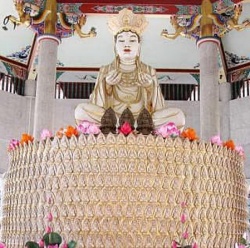Gandhakuti
Gandhakuti; The name given to the special apartment occupied by the Buddha at the Jetavana monastery (J.i.92). The building, of which the Gandhakuti formed a part, was evidently called the Gandhakuti-parivena, and there the Buddha would assemble the monks and address them (E.g., J.i.501; iii.67). The site, on which stands the bed of the Buddha in the Gandhakuti, is the same for every Buddha, and is one of the unalterable sites – avijahitatthānāni (BuA.247).
The name Gandhakuti seems to have been used later in reference also to other residences of the Buddha. Thus, we are told (AA.i.226; see C.S.B., Pl.5B) that Visākhā built a Gandhakuti for the Buddha in the Pubbārāma with the money she obtained by the sale of her Mahālatāpasādhana. For further details see Buddha. Jetavana was one of the most famous Buddhist monasteries. It was the second monastery donated to the Buddha after Veluvana in Rajagaha. Jetavana is situated just outside the city limits of Sarvatthi. This was the place where Buddha lived more than in any other place. He spent some nineteen Vassana seasons here. Some of the most important teachings and discourses were delivered here at Jetavana.
The Jetavana monastery was donated to the Buddha by Anathapindika, one of Buddha’s greatest benefactors. Originally the land was owned by Prince Jeta, son of King Pasenadi. At first Prince Jeta was reluctant to sell the land. Anathapindika covered the land with gold coins in order to buy it. Then the prince agreed and he himself built a huge gateway to the monastery. Jetavana is presently an historical park with ruins of a large number of monasteries and buildings especially Gandhakuti and Kosambakuti two chambers used by the Buddha. The most revered place in Jetavana is the Gandhakuti or Fragrant Chamber which was the personal chamber of the Buddha. Everyday devotees offered large amount of flowers to the Buddha which left a continuous fragrance lingering in his chamber and hence came to be called Gandhakuti - the Fragrant Chamber. In Jetavana is also found the second holiest Bodhi tree of the Buddhists, the Ananda Bodhi tree. It was a sapling of the Maha Bodhi Tree in Buddhagaya which was planted by Ven. Ananda as an object of veneration.
